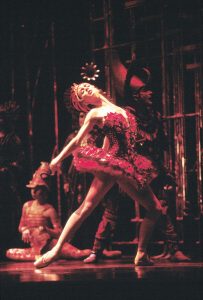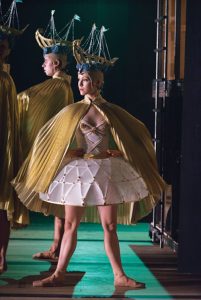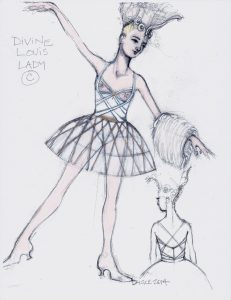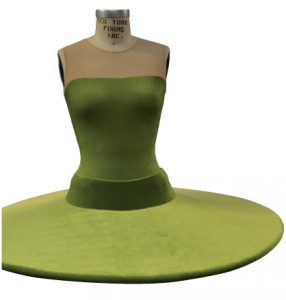The Tutu: An Endangered Species - Vancouver Ballet Society
- Home
- Features 2015 - 2019
- The Tutu: An Endangered Species

by Karen Barr

Photo: Erik Tomasson
The creation of a tutu, that iconic symbol of ballet, requires the expertise of a seasoned cutter and stitcher; they are time consuming and expensive to make. Despite their enduring popularity, budget cuts within the arts have led to fewer new tutus being built; with so few opportunities to practise, the concern is how costume makers can retain their skills and pass them on to future generations.
Most ballet companies employ very few full-time cutters and stitchers. The National Ballet of Canada, for instance, has two cutters and three stitchers. The company had its last major tutu build with John Neumeier’s Nijinsky for the 2012-2013 season. Of the 300 costumes and pieces built for this production, there were two Romantic tutus (cut to mid-calf) and eight Degas, or bell, tutus (cut to the knee).
The Royal Winnipeg Ballet, which employs only two cutters, has eight stitchers. “It’s been a tutu year for us!” exclaims wardrobe director Alena Zharska. For its most recent season, the tutus from Swan Lake had to be remade and the original fabrics sourced from Italy. Twenty-four new tutus were built. The project took three months. An additional 10 to 12 were built for the RWB’s school. The company seems to be creating an above average number of tutus per year and will even make tutus for others if commissioned.

Photo: Cylla von Tiedemann
Houston Ballet’s team of three cutters and two stitchers has a number of tutus to build for the 2016-2017 season, including Romantic tutus for the Willis in Giselle and a variety of styles for a new production of The Nutcracker. Yet Laura Lynch, Houston Ballet’s wardrobe manager, says there are members of her team who have never made one. “If there is staff turnover, the new staff may not have the skills. Making a tutu is intimidating. It’s not hard, it’s just very systematic.”
The cutter starts with a pattern to cut out the fabric pieces. The bottom part of the tutu consists of a panty and basque (the top part of the skirt from waist to high on the hip). To the panty, four to 14 layers of tulle or netting are added, each at various lengths. Each layer is hand pleated to form the skirt. The panty is then attached to the basque and placed on a mannequin, and a long needle is used to tack and sculpt the tutu. Romantic tutus are constructed with tulle cut all one length, to suit the height of the dancer, and usually have a separate panty worn over tights.
Shaping the skirt can be a challenge, especially today when tutu designs are so varied.

Photo: Samanta Katz
Marjory Fielding, wardrobe supervisor for the National Ballet of Canada, remembers the difficulty in creating the title character’s tutu for James Kudelka’s The Firebird in 2000, because at the back it had to look like the tail of a bird. Zharska and her team at the Royal Winnipeg Ballet recently completed some of their most challenging tutus to date in Mark Godden’s Going Home Star — Truth and Reconciliation. One tutu looks like an Elizabethan collar: a long ruff was attached to a stiff band using cartridge pleats, then attached to the basque. Another tutu was built with wires to look like a cage.
Once the skirt is complete, the bodice is built with or without boning, but either way it must fit the ballerina’s figure precisely. The plate (the top layer that sits on the gathered layers) of the tutu is then attached.
Typically, one week is needed to complete the panty and the netting for each tutu. It takes an additional several weeks to complete the bodice, depending on how elaborate the embellishment is. This could include beading, appliqués, lace, embroidery and ribbondry.
Tutus are an investment for the company, so they are built to last, usually with the finest fabrics and embellishments. It is not uncommon for these pieces to last more than two decades. Patti Fitzpatrick, interim head of women’s wardrobe for San Francisco Ballet, just re-embellished a 27-year-old Black Swan costume from Swan Lake. The National Ballet of Canada still has 58 tutus built for their 1998-1999 Swan Lake, which Fielding confirms are in beautiful condition. Of course, as Lynch points out, “Once they are built you need space to store them.”

Also, tutus must be danceable. Fitzpatrick remembers building one of the company’s most difficult tutus, for the Snow Queen from The Nutcracker. “This tutu was designed in such a way that the ballerina’s hip was lost in the costume. Her partner could not feel her hip, making it impossible to lift her. The tutu had to be altered several times.”
In the past, there were many tutu-centric ballet productions. But times are changing. Choreographers and designers may decide to set even the most classical ballet in current times, buying clothing off the rack, without a tutu in sight.
Renting tutus from other ballet companies can cut costs. San Francisco Ballet has 20 white Degas tutus they have often traded with the National Ballet of Canada for their 20 white pancake tutus (a short flat skirt). Slashed budgets have also resulted in co-productions, with one set of newly designed costumes split between two companies. This means one wardrobe department has lots of work, while the other has none.

Photo: Ava Jerao, courtesy of the Royal Winnipeg Ballet
With fewer tutus being built, will tutus become a lost art? All the heads of wardrobe I spoke with agree there are many excellent costume and fashion design programs that do offer training in tutu-making. But, with so few jobs available, working hands-on with an experienced mentor is rare, especially since occasional freelance work is for many the only way into a company’s wardrobe department. While ballet companies will likely always require tutus, the opportunities to build them are resting in fewer hands.
“Costume building is a lot like dance — the skills involved are best passed from one generation to the next. When the transfer of skills is broken, knowledge can easily be lost,” says Fielding.

